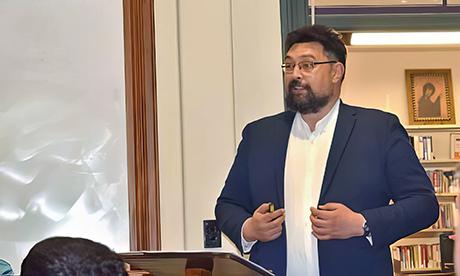Focusing on his own spiritual journey, Hemi Ropata SM says that despite the sexual abuse crisis, people are generally supportive of his exploring a priestly vocation.
Addressing a gathering of Auckland Catholic Young Adults, Ropata shared that there is always a question that ‘kind of hangs in the air’, why do you want to join a group that is so horribly disfigured and damaged?
Acknowledging what has happened and the serious effect it has on people, Ropata indicated that good also happens.
Ropata is in his sixth year of study towards priesthood and is studying theology in Rome. He has returned home to stay connected with New Zealand.
He suggested his journey is tangled with some people’s question – why remain within the Church amid the sexual abuse crisis?
Quoting authors such as T.S. Eliot, Flannery O’Connor, J.R.R. Tolkien and Bishop Robert Barron, Ropata indicated he read widely and draws inspiration from various spiritual writers.
Helping to progress an answer to the question, Ropata borrowed one of Barron’s ideas saying the church is a mixed “union of contraries,” such as grace/nature and body/soul. Ropata labelled it a “both-and” mentality and said there has always been both good and bad in the church.
Pure church – pure society
CathNews reports that in a recent address at the Vatican, Pope Francis echoes a similar idea. Referring to the Gospel passage about wheat and weeds, the pope said that a “pure church” and a “pure society” do not exist.
“When we see ‘wheat’ and ‘weeds’ living side by side in the world, what should we do? How should we react?” asked Francis.
Francis said the Gospels carve out ways of confronting evil.
Holiness, tradition, scriptures
Ropata told the group that from his experience, the human soul yearns for holiness and that, while we can be inspired by the lives of the holy women and men whom tradition says are in Heaven, we can also draw inspiration from those among us who answer today’s challenges.
“The saints always point to Christ. . . . There are the great saints in heaven, but there are also the saints here on earth. You have got people here in our Church who point to God, by their lives, by what they do, by the way they do it,” he said.
Ropata quoted from his current favourite spiritual writer, Carlo Caretto.
“No, I cannot free myself from you, because I am you, although not completely. And where should I go? To build myself another Church? But I could build one only with the same defects, because they are mine, defects which I have inside myself. And if I build one, it would be my church, no longer the Church of Christ.”
Ropata then highlighted these inspirational lives by focussing on the Sacraments, saying that the Catholic church is both the Church of Christ and a Church of the Sacraments.
Holding out a challenge to the young people, Ropata echoed Peter’s response to Christ, “Lord, to whom would we go? You have the words of eternal life,” and suggested the Sacraments are signs of the sacred presence of God in our lives.
To conclude, Ropata returned to the dichotomy of good and evil.
The Church has the capacity to be both beautiful and scandalous. The sexual abuse crisis has horribly disfigured us, but the lives of the saints, the teachings of the Church and the scriptures, call us forward to make a positive difference.
“The Church is beautiful, and it is the source from which we receive all that is good,” said Ropata.
Source
